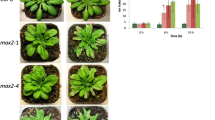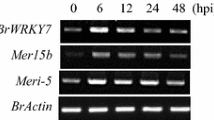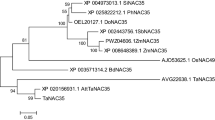Abstract
BAK1 and BKK1 are receptor-like protein kinases (RLKs) involved in brassinosteroid signal transduction and plant resistance to bacteria and fungi. Here we report that loss-of-function mutants of BAK1 or BKK1 in Col-0 showed enhanced susceptibility to Turnip crinkle virus (TCV) infection. Cell death and chlorosis occurred much earlier in bak1-4 and bkk1-1 mutants than in wild-type plants, suggesting an important role of BAK1 and BKK1 in controlling cell death associated with TCV infection. The bak1-4 and bkk1-1 mutants showed the elevated transcription levels of pathogenesis genes, such as PR1, PR2, PR5, PDF1.2. Enhanced expression of these genes, however, failed to resist the transport of TCV virus. At 9 days postinoculation, TCV levels were the highest in the systemic leaves of bak1-4, but were undetected in BAK1 or BKK1 overexpressing plants. These results signify that both BAK1 and BKK1 are important components in controlling TCV infection in Arabidopsis plants.




Similar content being viewed by others

References
Carrington, J. C., Heaton, L. A., Zuidema, D., Hillman, B. I., & Morris, T. J. (1989). The genome structure of Turnip crinkle virus. Virology, 170, 219–226.
Chinchilla, D., Zipfel, C., Robatzek, S., Kemmerling, B., Nurnberger, T., Jones, J. D., et al. (2007). A flagellin-induced complex of the receptor FLS2 and BAK1 initiates plant defence. Nature, 448, 497–500. doi:10.1038/nature05999.
Chisholm, S. T., Coaker, G., Day, B., & Staskawicz, B. J. (2006). Host-microbe interactions: shaping the evolution of the plant immune response. Cell, 124, 803–814. doi:10.1016/j.cell.2006.02.008.
Cooley, M. B., Pathirana, S., Wu, H. J., Kachroo, P., & Klessig, D. F. (2000). Members of the Arabidopsis HRT/RPP8 family of resistance genes confer resistance to both viral and oomycete pathogens. Plant Cell, 12, 663–676. doi:10.1105/tpc.12.5.663.
Feys, B. J., & Parker, J. E. (2000). Interplay of signalling pathways in plant disease resistance. Trends in Genetics, 16, 449–455. doi:10.1016/S0168-9525(00)02107-7.
Greenberg, J. T., & Yao, N. (2004). The role and regulation of programmed cell death in plant-pathogen interactions. Cellular Microbiology, 6, 201–211. doi:10.1111/j.1462-5822.2004.00361.x.
Greenberg, J. T., Silverman, F. P., & Liang, H. (2000). Uncoupling salicylic acid-dependent cell death and defense-related responses from disease resistance in the Arabidopsis mutant acd5. Genetics, 156, 341–350.
He, K., Gou, X., Yuan, T., Lin, H., Asami, T., Yoshida, S., et al. (2007). BAK1 and BKK1 regulate brassinosteroid-dependent growth and brassinosteroid-independent cell-death pathways. Current Biology, 17, 1109–1115. doi:10.1016/j.cub.2007.05.036.
Heath, M. C. (1998). Apoptosis, programmed cell death and the hypersensitive response. European Journal of Plant Pathology, 104, 117–124. doi:10.1023/A:1008645520976.
Heath, M. C. (2000). Hypersensitive response-related death. Plant Molecular Biology, 44, 321–334. doi:10.1023/A:1026592509060.
Hecht, V., Vielle-Calzada, J. P., Hartog, M. V., Schmidt, E. D., Boutilier, K., Grossniklaus, U., et al. (2001). The Arabidopsis SOMATIC EMBRYOGENESIS RECEPTOR KINASE 1 gene is expressed in developing ovules and embryos and enhances embryogenic competence in culture. Plant Physiology, 127, 803–816. doi:10.1104/pp.010324.
Heese, A., Hann, D. R., Gimenez-Ibanez, S., Jones, A. M., He, K., Li, J., et al. (2007). The receptor-like kinase SERK3/BAK1 is a central regulator of innate immunity in plants. Proceedings of the National Academy of Sciences of the United States of America, 104, 12217–12222. doi:10.1073/pnas.0705306104.
Kachroo, P., Yoshioka, K., Shah, J., Dooner, H. K., & Klessig, D. F. (2000). Resistance to Turnip crinkle virus in Arabidopsis is regulated by two host genes and is salicylic acid dependent but NPR1, ethylene, and jasmonate independent. Plant Cell, 12, 677–690. doi:10.1105/tpc.12.5.677.
Kemmerling, B., Schwedt, A., Rodriguez, P., Mazzotta, S., Frank, M., Qamar, S. A., et al. (2007). The BRI1-associated kinase 1, BAK1, has a brassinolide-independent role in plant cell-death control. Current Biology, 17, 1116–1122. doi:10.1016/j.cub.2007.05.046.
Lam, E. (2004). Controlled cell death, plant survival and development. Nature Reviews. Molecular Cell Biology, 5, 305–315. doi:10.1038/nrm1358.
Li, J., Wen, J., Lease, K. A., Doke, J. T., Tax, F. E., & Walker, J. C. (2002). BAK1, an Arabidopsis LRR receptor-like protein kinase, interacts with BRI1 and modulates brassinosteroid signaling. Cell, 110, 213–222. doi:10.1016/S0092-8674(02)00812-7.
Lucas, W. J. (1995). Plasmodesmata: Intercellular channels for macromolecular transport in plants. Current Opinion in Cell Biology, 7, 673–680. doi:10.1016/0955-0674(95)80109-X.
Nakashita, H., Yasuda, M., Nitta, T., Asami, T., Fujioka, S., Arai, Y., et al. (2003). Brassinosteroid functions in a broad range of disease resistance in tobacco and rice. Plant Journal, 33, 887–898. doi:10.1046/j.1365-313X.2003.01675.x.
Nam, K. H., & Li, J. (2002). BRI1/BAK1, a receptor kinase pair mediating brassinosteroid signaling. Cell, 110, 203–212. doi:10.1016/S0092-8674(02)00814-0.
Opalka, N., Brugidou, C., Bonneau, C., Nicole, M., Beachy, R. N., Yeager, M., et al. (1998). Movement of rice yellow mottle virus between xylem cells through pit membranes. Proceedings of the National Academy of Sciences of the United States of America, 95, 3323–3328.
Penninckx, I. A., Eggermont, K., Terras, F. R., Thomma, B. P., Samblanx, G. W., Buchala, A., et al. (1996). Pathogen-induced systemic activation of a plant defensin gene in Arabidopsis follows a salicylic acid-independent pathway. Plant Cell, 8, 2309–2323.
Pilloff, R. K., Devadas, S. K., Enyedi, A., & Raina, R. (2002). The Arabidopsis gain-of-function mutant dll1 spontaneously develops lesions mimicking cell death associated with disease. Plant Journal, 30, 61–70. doi:10.1046/j.1365-313X.2002.01265.x.
Shan, L., He, P., Li, J., Heese, A., Peck, S. C., Nurnberger, T., et al. (2008). Bacterial effectors target the common signaling partner BAK1 to disrupt multiple MAMP receptor-signaling complexes and impede plant immunity. Cell Host & Microbe, 4, 17–27. doi:10.1016/j.chom.2008.05.017.
Uknes, S., Mauch-Mani, B., Moyer, M., Potter, S., Williams, S., Dincher, S., et al. (1992). Acquired resistance in Arabidopsis. Plant Cell, 4, 645–656.
Wang, Y., Gaba, V., Yang, J., Palukaitis, P., & Gal-On, A. (2002). Characterization of Synergy Between Cucumber mosaic virus and Potyviruses in Cucurbit Hosts. Phytopathology, 92, 51–58. doi:10.1094/PHYTO.2002.92.1.51.
Whitham, S., Dinesh-Kumar, S. P., Choi, D., Hehl, R., Corr, C., & Baker, B. (1994). The product of the tobacco mosaic virus resistance gene N: similarity to toll and the interleukin-1 receptor. Cell, 78, 1101–1115. doi:10.1016/0092-8674(94)90283-6.
Xi, D., Feng, H., Lan, L., Du, J., Wang, J., Zhang, Z., et al. (2007). Characterization of Synergy between Cucumber mosaic virus and Tobacco necrosis virus in Nicotiana benthamiana. Journal of Phytopathology, 155, 570–573. doi:10.1111/j.1439-0434.2007.01279.x.
Yao, N., Imai, S., Tada, Y., Nakayashiki, H., Tosa, Y., Park, P., et al. (2002). Apoptotic Cell Death is a Common Response to pathogen Attack in Oats. Molecular Plant-Microbe Interactions, 15, 1000–1007. doi:10.1094/MPMI.2002.15.10.1000.
Zipfel, C., Kunze, G., Chinchilla, D., Caniard, A., Jones, J. D., Boller, T., et al. (2006). Perception of the bacterial PAMP EF-Tu by the receptor EFR restricts Agrobacterium-mediated transformation. Cell, 125, 749–760. doi:10.1016/j.cell.2006.03.037.
Acknowledgments
This work was supported by the National Key Basic Research“973” Program of China (2009CB118500), National Natural Science Foundation of China (30970214, 30670166) and Project of Chinese Ministry of Education (108110). We thank Anne Simon for providing TCV antibody.
Author information
Authors and Affiliations
Corresponding authors
Rights and permissions
About this article
Cite this article
Yang, H., Gou, X., He, K. et al. BAK1 and BKK1 in Arabidopsis thaliana confer reduced susceptibility to turnip crinkle virus . Eur J Plant Pathol 127, 149–156 (2010). https://doi.org/10.1007/s10658-010-9581-5
Accepted:
Published:
Issue Date:
DOI: https://doi.org/10.1007/s10658-010-9581-5



